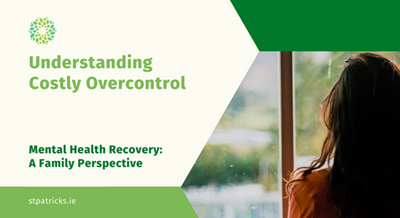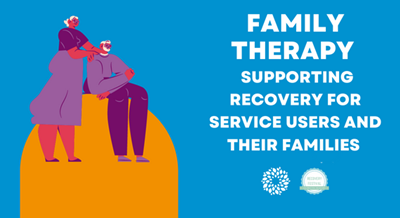
A new study from our Psychology Department suggests particular benefits from a multifamily group approach to support adolescents with emotion regulation difficulties.
The study explores the experiences of participants in a multifamily group intervention which brings young people, their parents and clinicians together to support young people in managing their emotions.
Results from the study, published in the Counselling and Psychotherapy Research journal, indicate that interventions of this type may help to improve symptoms and enhance relationships for adolescents with emotion regulation difficulties. They also demonstrate a number of significant benefits for parents through this approach.
This was a collaborative project between the Psychology Department at St Patrick’s Mental Health Services (SPMHS) and staff from the Department of Psychology at University of Limerick (UL). The SPMHS input was led by Dr Clodagh Dowling, Director of Psychology here in SPMHS, and Dr Claire O’Driscoll Lawrie and Dr Kevin O’Hanrahan, Senior Clinical Psychologists with our Psychology Department. They were joined by Dr Ruth Cleary and Dr Sharon Houghton of the Department of Psychology in UL as part of Dr Cleary’s doctoral research. This is the first published evaluation of this intervention.
You can see the full study findings here.
Overview of the intervention
Overcontrol and undercontrol are psychological concepts which both involve difficulties in regulating, or managing, emotion. In simple terms, overcontrol can be thought of as when someone has too much self-control, such as suppressing their emotions and impulses or being extremely self-disciplined. Undercontrol is when someone has very low levels of self-control: they may be highly expressive in their emotions, have strong reactions, and find it hard to manage their impulses and behaviours.
Dialectical behaviour therapy (DBT) is a type of therapy which supports people to manage their emotions and can therefore be very helpful for people experiencing overcontrol or undercontrol. It is a transdiagnostic treatment, which means it can be used for people with different types of mental health difficulties. In its full form, DBT has four elements: consultation for therapists, individual therapy, telephone coaching, and skills training. The latter includes delivering modules on mindfulness, distress tolerance, emotion regulation, and more. DBT for adolescents (DBT-A) is a form of DBT specifically for young people, which makes the skills materials more accessible for that age group, requires parents to attend the skills training, and adds a module around dealing with dilemmas that can come up in parent-child relationships.
Meanwhile, Group Radical Openness (GRO) is a group therapy, developed by clinicians here in SPMHS, which targets overcontrol. It uses relationships and social engagement within the group to help people develop healthy emotion regulation.
The intervention explored in this study is am SPMHS psychology day programme, which is a group-based intervention for adolescents aged 12 to 18 with various mental health difficulties who have difficulties with regulating their emotions. It integrates, or combines, the structure and skills training in DBT-A with exercises and approaches from GRO. This combination recognises that people can “exhibit traits of both over- and undercontrol, something that appears to be especially true in adolescence” when young peoples’ personalities and behaviours vary as their coping strategies change. Because of this, it can be “difficult to identify distinct groups of overcontrolled or undercontrolled adolescents to provide tailored treatment” to in line with a particular emotion regulation style.
The group runs for a 20-week cycle, with the first half attended by adolescents only and the second half attended by the adolescents with their parents in a multifamily group format. It runs on a rolling basis, which means that adolescents and/or parents can join at different points in the 20-week cycle.
In the period under review for this study, the group was delivered online due to restrictions during the COVID-19 pandemic.
Method of the study
The study involved gathering perspectives from adolescents and parents who took part in the intervention and clinicians who facilitated it. Seven parents and six adolescents from seven family units, and six clinicians, took part in total.
Each participant in the study engaged in a semi-structured interview which took place online between one and three weeks after the intervention and which was designed to explore their personal experiences of the intervention: they were asked about their experiences of and expectations for it, their relationships before and after it, any change they felt had taken place, and more.
Data from the interviews was analysed, generating a number of themes which reflected the data and could easily be used to inform future service provision.
Findings
Analysis of the research data identified nine themes overall, with six sub-themes. Most themes incorporate perspectives from all stakeholders, with it being noted where a theme or sub-theme represents one specific stakeholder groups’ views. Overviews of the themes and sub-themes are outlined below.
-
Seeking change
All participants reported that “parents and adolescents came to a group seeking change”. Adolescents particularly wanted to find “new ways of coping with emotion, rather than eradication of symptoms”, with clinicians reporting the latter was important to parents too. Adolescents and parents both also wanted to “change parent responses to adolescent distress”.
-
A bit unsure… but I’ll give it a go
“Most parents and adolescents described hesitance, scepticism and uncertainty” when joining the group and in its early stages, with the time commitment involved feeling daunting to many. However, the commitment and intensity of the intervention was something they found important when looking back. Aspects that they found difficult in the beginning, such as opening up, became easier over time.
-
Cultivating awareness and acceptance of emotion
Adolescents described a process of “bringing awareness to and accepting their emotions” through the intervention, along with reflecting on the link between their emotions and behaviours. Every parent described how difficult they found it to think and talk about emotion, with many reporting that they learned about emotions through the group and/or noting they had not fully appreciated their child’s emotional experiences beforehand.
-
Skills provided new ways of responding
Participants highlighted the helpfulness of skills learned through the intervention and the ways they apply in everyday situations. Each adolescent noted that the skills helped them to respond differently, while parents explained the skills prompted them to think differently about their child’s distress. For parents and clinicians, the way parents moved from fixing or problem-solving distress to being more able to sit with it was particularly notable.
-
Functional improvements
While all adolescents and parents explained they could still have difficulties or bad days, all adolescents reported having “increased capacity to cope with difficulties” that did come up.
-
Relationship change
Improved relationship with self
All adolescents described having difficult relationships with themselves before the group, with self-criticism, poor body image, and self-blame among the kinds of problems coming up for them. After the group, most adolescents reported improved self-image and less self-criticism. Parents and clinicians observed adolescents being “happier with themselves” or having more confidence. Some parents noted their child was “beginning to accept themselves, including the parts of themselves that suffered”. In addition, parents reported becoming more accepting of themselves in the process.
Improved parent-child relationship
Most families reported “improved or more mature relationships” after the group, with clinicians observing less conflict and more warmth and openness.
Improved peer relationships
Each adolescent reported improvements in their relationships with peers, with most describing becoming “more socially engaged”. Parents also observed their children having more friends, performing better in school, and being more engaged at home.
-
Everything coming together
One theme which came from parents and clinicians only was that, although they found it hard to articulate how this happened, the different aspects of the group seemed to click together to make it effective or helpful.
-
Shared language for communicating about emotion
Parents, adolescents, and clinicians all reported that improvements in relationships were helped by “an increase in communication and openness” between parents and children. They described this coming through the group providing a shared language to express and communicate emotions. Feedback from parents included that they had found ways of talking about emotions on the young person’s terms.
-
Group context
Being in a group together facilitated mutual understanding
All adolescents saw the value of their parents attending the group and most enjoyed being in a group with their parents, but preferred the adolescent-only half of the group cycle. Parents found it beneficial to attend the group, and valued the time this gave them with their child. Some adolescents and parents described developing a mutual understanding through being in the group together.
Group safety and connection
All adolescents “valued being in a group with people who had similar difficulties” and most parents valued the same. Safety and connection were created and a sense of normalisation felt though the support of group facilitators, and through “being social, talking with others, opening up, receiving advice, and seeing others who were struggling in similar ways”.
Rolling group highlighted progression
A subtheme found from parent and clinician data was that, while parents and clinicians reported the group taking place on a rolling basis as disruptive at times, the rolling nature also gave opportunities for reflection. For parents who had been in the group for some time already, meeting new group members brought back to them the progression they had made. They also found they took on new roles as guides to newcomers. For parents who were in the early stages of joining the group, seeing others finishing their cycle and leaving also gave them hopes for their family’s own progression through it.
Discussion of and recommendations from findings
Overall, findings from this study suggest that parents and adolescents “experienced the integration of DBT-A and GRO as positive and helpful overall”. Participants reported a process which helped them to develop awareness of emotion and acceptance of it, as well as finding new ways to respond to emotion and distress. They described improvements in experiences of emotion, their relationships with themselves, social connection, parent-child relationships, and more. The intervention also provided them with a shared language they could use to express emotions and distress, which strengthened openness and communication between parents, children and, for some, wider family units.
The experience of parents became a striking feature of the study, with results showing that, where parents saw changes for adolescents, parents also reported “parallel changes for themselves in almost all areas”. Many difficulties linked with overcontrol and undercontrol in adolescents are said to come from invalidating family environments. This finding that the intervention helps to develop parents’ own skills in emotion regulation – along with other findings, such as the development of a shared language between parent and child – indicates this intervention may help “in targeting both the underlying causes and maintaining factors in adolescent distress”.
A key strength of the study lies in its direct representation of the experience of service users “in the hope of using their voices to guide future service provision”. These experiences and the findings from them provide a number of implications for clinicians working with adolescents. For example, the usefulness of both the multifamily group format and its rolling basis are evident through the study findings, indicating that facilitating groups of this type may help to build connection between parents and children and create opportunities for learning from others. Acknowledging, normalising and validating the commitment that adolescents and parents make through such a group is also a useful step for clinicians to take to help support attendance and motivation.
Overall, this study can be found to demonstrate the acceptability and feasibility of this intervention, “with broad implications for the treatment of emotional dysregulation in adolescence”.


